Introduction
How To Train A Pigeon: Pigeons, often regarded as the “rats of the sky” by some, have a fascinating history intertwined with human civilization. These unassuming birds have played pivotal roles throughout history, from serving as messengers in ancient times to gracing cityscapes with their graceful flight today. However, there’s more to pigeons than meets the eye, and one can’t help but wonder how to harness their innate intelligence and abilities. This is where the art of training pigeons pets comes into play. Training a pigeon is a unique endeavor that combines science, patience, and a deep understanding of avian behavior. Unlike dogs or horses, pigeons possess their own set of instincts and idiosyncrasies that require a specialized approach.
Whether you’re interested in homing pigeons for message delivery, performing pigeons for entertainment, or simply fostering a deeper connection with these remarkable birds, learning how to train them is a rewarding pursuit. This demystify the process of training pigeons, offering insights into their behavior, the tools you’ll need, and the step-by-step methods to transform a wild pigeon into a skilled and obedient companion. Whether you’re an amateur enthusiast or a seasoned pigeon fancier, the principles and techniques discussed here will serve as a valuable resource on your journey to pigeon training mastery.
Before delving into the nitty-gritty of pigeon training, it’s essential to appreciate the unique qualities that make these birds worthy of our attention. Pigeons, also known as rock doves, are highly intelligent creatures with an extraordinary ability to navigate and memorize their surroundings. Their innate homing instinct has made them legendary in the realm of message carriers and, in recent times, even the subject of scientific research in the field of animal cognition. To successfully train a pigeon, you’ll need to understand their behavior, communicate with them effectively, and employ various training methods tailored to their specific talents and characteristics
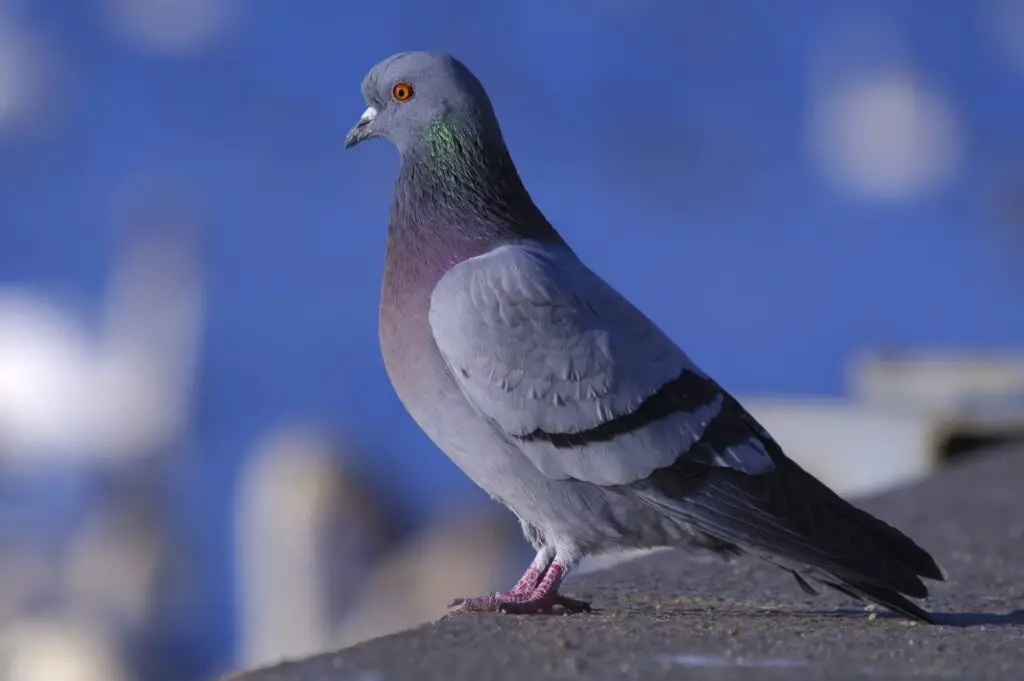
How long does it take to train a pigeon?
Gradually during the course of the multi-week training period, you’ll release the young pigeon from points farther and farther away from the loft entrance, and from a variety of locations. This trains the bird to fly home from any release point. The homing instinct is established at about 8 weeks.
The purpose for which a pigeon is being trained plays a crucial role in determining the training duration. For instance, training a pigeon for a simple task like responding to a particular cue may take less time than training it for more complex tasks such as racing or navigation.
Younger pigeons tend to be more receptive to training than older ones. Training a young pigeon from the moment it can fly will likely yield quicker results compared to trying to train an older bird with established behaviors. Just like humans have varying degrees of talent in different areas, pigeons also have varying levels of aptitude. Some pigeons may naturally excel at certain tasks, making their training more efficient.
The complexity of the task at hand can also influence training duration. Teaching a pigeon to perform a simple trick may take a matter of days or weeks, while training a pigeon for advanced tasks like competitive racing can take several months or even years.
How do you get a pigeon to trust you?
One way to get street pigeons to trust you is to offer them food. If you can get close enough, try holding out a piece of bread or some other type of food and see if the pigeon takes it from your hand. Once they start trusting you, you can try petting them gently on the head or back.
If you wish to interact with pigeons regularly, consider setting up a dedicated space, such as a balcony or garden, where pigeons can visit without feeling threatened. Ensure the area is free from potential dangers, like lurking pets or loud noises. Food is the bridge to a pigeon’s heart. Begin by placing birdseed or pigeon-friendly food in the designated area. Initially, scatter it at a distance to avoid alarming them. Over time, place the food closer to your presence.
Pigeons are cautious by nature, and they may take time to get accustomed to your presence. Be patient and visit the designated area regularly, maintaining a consistent routine. Pigeons appreciate predictability. Sudden movements or loud noises can startle pigeons, causing them to retreat. Move slowly and calmly when around them. If you must approach, do so gradually.
Give pigeons their personal space. Allow them to come to you at their own pace. Avoid chasing or attempting to handle them, as this can break their trust. Pigeons appreciate a reliable source of clean water and shelter. Providing these essentials can further cement their trust in your presence.
How do you start training pigeons?
We train them by letting them out to fly around their home area and then slowing taking them further and further away from their home loft and letting them fly back. This means we catch all the birds and pack them in cages and drive them to the release site and then drive back to the home site to meet them.
Before you embark on pigeon training, it’s crucial to gather knowledge about pigeons and the specific training goals you have in mind. Research their behavior, needs, and natural instincts. Understanding the species will lay the foundation for effective training. Choose pigeons that are healthy, young (preferably under one year old), and have not been exposed to stressful or negative experiences. Younger pigeons are generally more receptive to training.
Designate a secure training space, such as a loft or aviary, where the pigeons can feel safe and comfortable. Ensure the area is free from potential hazards and protection from predators and adverse weather conditions. Begin by spending time near the pigeons without imposing any training tasks. This will help them become accustomed to your presence. Offer food and water regularly to create a positive association between you and nourishment.
Start with basic obedience training. Train pigeons to respond to simple cues like a whistle, clicker, or hand signal. This training can help establish communication between you and your pigeons. A common training method is operant conditioning, where you reward desired behaviors with treats. To prevent your pigeons from getting lost during training sessions, pigeon-proof your loft or training area. Ensure there are no gaps or openings through which they can escape.
What age are pigeons ready to fly?
Young pigeons bred for meat are known as squabs. Squabs have never flown and have never usually eaten anything except ‘pigeon milk’, which is formed in the crops of both parents during the incubation period. Squabs are ready to fly and leave their nest at about 26–30 days of age.
When a pigeon hatches, it is in a highly vulnerable state, completely dependent on its parents for warmth, food, and protection. During the initial days, pigeon chicks are not ready to fly; they are typically blind, featherless, and unable to maintain body temperature. Pigeon chicks start developing their feathers at around 7 to 10 days of age. Initially, these feathers appear as tiny pin feathers or “blood feathers,” which are still growing and not fully functional. During this stage, the chicks remain in the nest, relying on their parents for food and warmth.
The fledgling stage marks the beginning of a pigeon’s journey toward flight. This stage typically occurs between 25 to 30 days after hatching, depending on factors such as the pigeon’s species and environmental conditions. At this point, the chicks are covered in fully formed feathers and are capable of regulating their body temperature. During the fledgling stage, the young pigeons venture out of the nest and begin to explore their surroundings, often flapping their wings to strengthen their flight muscles. They may not be proficient flyers initially, and their flights are typically short and clumsy.
Pigeons learn to fly through a process of trial and error. They gradually improve their flying skills by practicing short flights and returning to their nest. The first few flights are essential for building strength and coordination. The age at which pigeons become proficient flyers can vary. Some may achieve stable flight within a few weeks, while others may take several months to become skilled aviators. Factors influencing this timeline include the pigeon’s individual development, the availability of space for practice, and the presence of experienced adult pigeons as role models.
What is pigeon afraid of?
What Do Pigeons Hate? Pigeons hate the sight or presence of other domineering birds, such as birds of prey. This is what makes falconry such a successful deterrent in getting rid of pigeon populations. Additionally, pigeons do not like strong smells, such as cinnamon or hot pepper juice or spray.
Pigeons are naturally wary of potential predators, as they are prey birds. Common predators of pigeons include birds of prey such as hawks, falcons, and owls. The sight of a raptor soaring overhead or perched nearby can send pigeons into a frenzy, prompting them to take flight or seek shelter. Pigeons have a heightened sensitivity to sudden movements and loud noises. Abrupt gestures, quick approaches, or loud, unexpected sounds can startle pigeons, causing them to scatter in panic. This wariness is an adaptive survival trait that helps them avoid potential threats.
Pigeons are creatures of habit, and they tend to be cautious around unfamiliar objects or structures. New to their environment, such as construction equipment or foreign objects, can make them nervous. Pigeons may avoid or fly away from these unfamiliar items until they determine that they pose no danger. While pigeons have adapted to urban life, they can still be uncomfortable in overly crowded or chaotic environments. Large gatherings of people, loud events, or bustling urban areas can make pigeons skittish, and they may seek refuge in quieter, less crowded spaces.
Pigeons may exhibit fear or avoidance behavior in response to direct human interaction, especially if they have had negative experiences with people. Chasing, attempts at capture, or loud and aggressive behavior can cause pigeons to perceive humans as threats. Pigeons are highly food-motivated birds, and the absence of a readily available food source can cause anxiety. In urban areas, pigeons are often seen foraging for scraps of food. A sudden scarcity of food can lead to restlessness and increased competition among pigeons.
Is it safe to touch a pigeon?
You do not have to be afraid of handling pigeons. They don’t bite and are harmless. (And your catching the pigeon is much less dangerous to the bird than a predator will be.) It is extremely rare for a human to get sick from a pigeon.
Pigeons can carry diseases and parasites, some of which can be transmitted to humans through direct contact or exposure to their droppings. One of the most well-known concerns is histoplasmosis, a fungal disease associated with bird droppings. While the risk of contracting diseases from casual contact with pigeons is generally low, it is essential to exercise caution.
Pigeons are easily stressed by human interaction. Handling them can cause fear and stress, which may lead to injuries to the bird or even unintentional harm to the person attempting to handle them. In many areas, it is illegal to harm or capture pigeons or other wild birds, as they are protected by wildlife conservation laws. Touching or capturing pigeons may be subject to legal consequences.
Zoonotic diseases are illnesses that can be transmitted between animals and humans. While pigeons can carry some zoonotic diseases, the risk of transmission through casual contact is generally low. Nonetheless, it is advisable to practice good hygiene after handling pigeons or being in areas where they congregate.
If yourself in a situation where you need to interact with pigeons, such as helping an injured bird or providing care for a pigeon, it’s essential to follow specific to ensure both your safety and the well-being of the bird. Wearing gloves and using hand sanitizer can reduce the risk of disease transmission. Avoid touching your face, especially your eyes, nose, and mouth, during and after handling pigeons.
What is the food for pigeon?
Feral pigeons eat a variety of foods including grains, seeds, cereal crops, plant seeds and peas. They will also feast on berries, fruits and vegetables. Pigeons are generally herbivores but they will eat insects, snails and worms when they need to.
Pigeons have a particular fondness for grains such as wheat, barley, corn, and millet. They also consume a variety of seeds, including sunflower seeds, safflower seeds, and various wild grass seeds. Pigeons occasionally feed on fruits like berries, cherries, and figs when available.
Pigeons will forage on various types of weeds and grasses, especially during the spring and summer months. While grains and seeds make up the bulk of their diet, pigeons will opportunistically eat insects and small invertebrates. In urban settings, pigeons adapt their diet to what is readily available. They are often seen scavenging for food scraps and handouts from humans.
Pigeons frequently consume bread, but it’s that a diet excessively high in bread can be harmful to them. Bread lacks the essential nutrients that pigeons need. Pigeons may also eat crackers, chips, and other similar snack foods when they find them.
Pigeons are opportunistic feeders and will scavenge for food scraps left by humans in parks and public areas. In areas where people feed birds, pigeons will readily consume birdseed. In some urban areas, feeding pigeons or other wildlife may be discouraged or prohibited by local regulations. Always be mindful of local ordinances and.
How do pigeons carry messages?
Pigeons are effective as messengers due to their natural homing abilities. The pigeons are transported to a destination in cages, where they are attached with messages, then the pigeon naturally flies back to its home where the recipient could read the message. They have been used in many places around the world.
Pigeons have been used as messengers for thousands of years, with documented instances dating back to ancient civilizations, including the Egyptians, Greeks, and Romans. They were particularly valued for their remarkable ability to reliably carry messages across great distances, even in challenging conditions.
Training pigeons for messaging involved imprinting them with the location of their home loft, which served as their base. Pigeon trainers would then release pigeons from various locations, and the birds would instinctively return to their home loft. Training involved gradually increasing the distance of these flights to improve the pigeons’ homing skills.
Messages were typically attached to the pigeon’s leg using a small, lightweight canister or capsule. These capsules were designed to be easily secured to the pigeon’s leg without impeding its flight. Messages could be written on small pieces of paper or parchment and rolled up to fit inside the capsule.
Once released with a message, pigeons relied on their extraordinary navigational abilities to find their way home. While the exact mechanisms behind their navigation are still not fully understood, scientists believe pigeons use a combination of visual, magnetic, and olfactory cues.
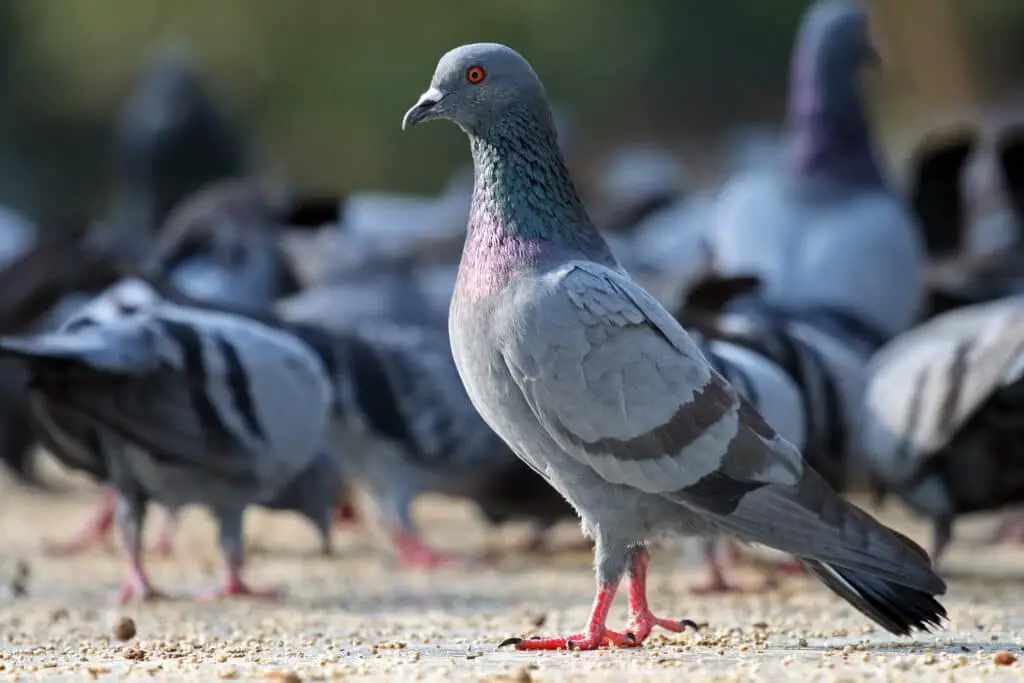
Conclusion
In the art of training a pigeon is a captivating and rewarding endeavor that offers a unique insight into the world of these remarkable birds. Throughout this we have explored the intricacies of pigeon behavior, the tools and techniques required for training, and the myriad of possibilities that arise from successfully nurturing a bond with these feathered companions. One of the key takeaways from our exploration is the recognition that pigeons are far more than just city-dwelling scavengers. They are intelligent, adaptable creatures with a rich history of cooperation with humans. From their crucial role as message carriers in times of war to their continued presence in our urban landscapes, pigeons have proven themselves to be both resourceful and resilient.
Understanding pigeon behavior is the cornerstone of effective training. By delving into their instincts, communication methods, and social dynamics, we can establish a strong foundation for building trust and cooperation. Whether you aspire to teach pigeons tricks for entertainment or harness their homing abilities for practical purposes, a solid understanding of their innate tendencies is essential. Equipped with the right you can select the most suitable pigeons for your training goals and create a nurturing environment that fosters their growth and development. Pigeons are highly adaptable, and with patience, consistency, and positive reinforcement, you can shape their behavior to meet your specific needs.
The journey of pigeon training is not without its challenges, but the rewards are profound. As you witness your pigeons respond to your commands, perform intricate tricks, or even complete long-distance flights, you’ll experience a sense of accomplishment and connection like no other. The bond forged through training is a testament to the incredible partnership that can exist between humans and animals. In training pigeons is an art that combines science, intuition, and dedication. It offers a unique opportunity to bridge the gap between species, fostering understanding, trust, and cooperation. So, whether you’re a novice embarking on your first training journey or an experienced pigeon fancier seeking to refine your techniques, that patience, and a genuine appreciation for these birds.

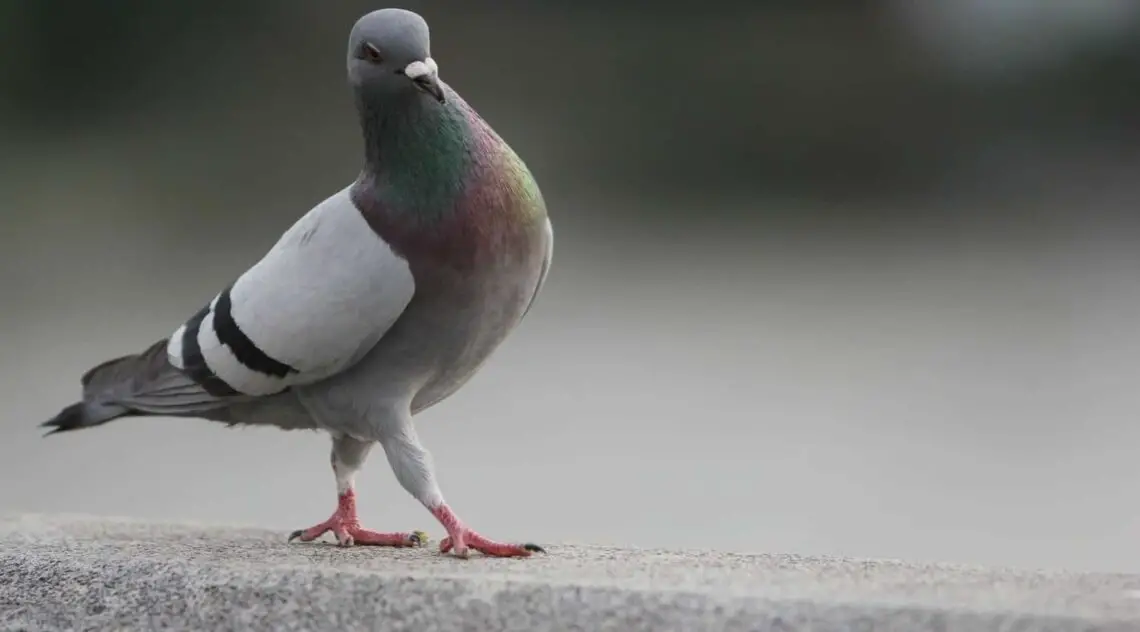
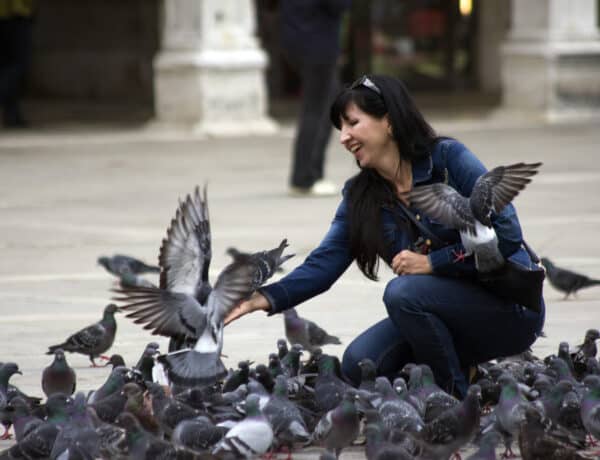
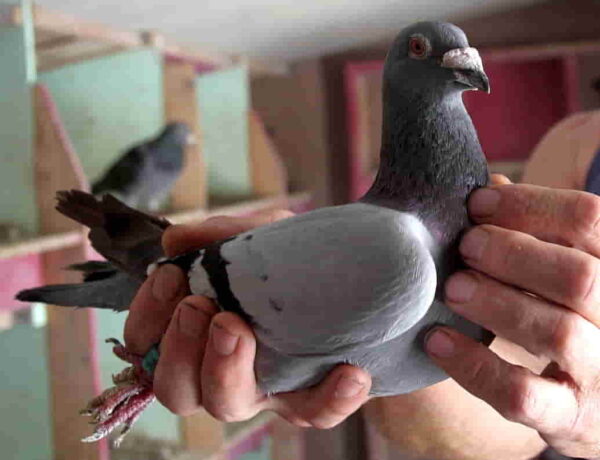
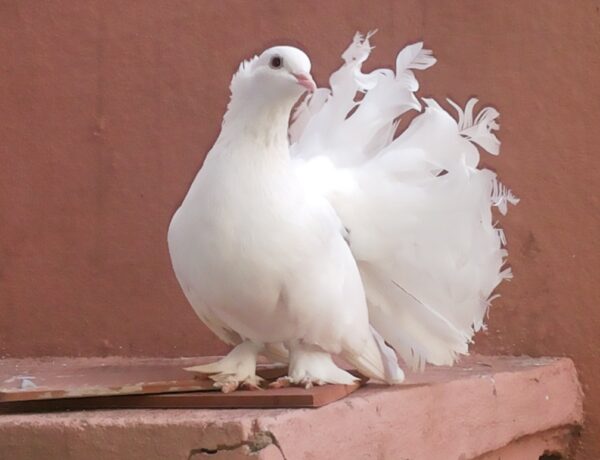
No Comments